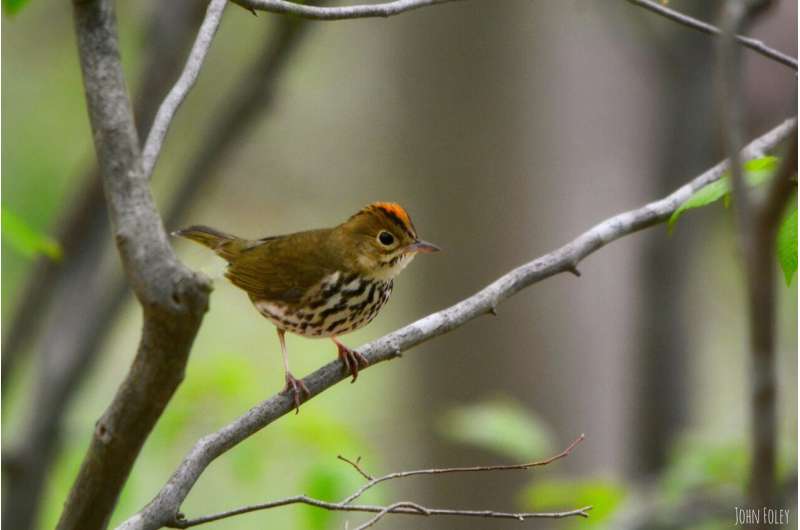Invasive shrub has no effect on prey abundance or physiological condition of migratory songbird

Alien plants often spell trouble for birds whose habitats are under siege. They can alter food abundance, nest site availability and other critical resources. However, a new study published this week in the journal Conservation Physiology shows that the relationships between exotic, invasive plants and native birds are not always that simple, and not always negative.
Researchers from the Great Hollow Nature Preserve & Ecological Research Center (New Fairfield, Connecticut) and Rochester Institute of Technology (Rochester, New York) found that Japanese barberry—one of the most widespread and vilified exotic shrubs in the northeastern U.S. – does not reduce habitat quality for a forest-breeding migratory songbird, the ovenbird, in a way that affects either its prey abundance or physiological condition. "While our findings may be somewhat of a surprise to some, we think they highlight the importance of investigating and understanding species-specific effects of non-native plants on wildlife rather than basing management decisions on broad generalizations and assumptions, which can have unintended consequences," said Chad Seewagen, one of the study's authors.
Japanese barberry was first brought to the U.S. through Boston in 1875 and by the 1960s had already spread throughout most of the Northeast. Yet, more than half a century later, we still know almost nothing about the effects of Japanese barberry on forest wildlife. For the past three years, Great Hollow's researchers and collaborators have been working to change that through a series of studies across multiple wildlife taxa. The first phase of their research, published last year, showed that the abundance and species richness of leaf-litter and branch-dwelling arthropods are significantly diminished in barberry-invaded areas of the forest, with spiders, ants, and other predatory taxa hit the hardest. However, it also showed that the overall biomass of arthropods is not affected by Japanese barberry because of the taxa associated with it tending to be larger-bodied than those associated with native vegetation in the uninvaded areas of the forest. This could mean that food availability for ground- and understory-foraging insectivores, like many forest songbirds, is not affected by the changes in arthropod community composition caused by Japanese barberry, provided they are not specialized to feed on any particular taxonomic groups.
To begin answering this question of how insectivores higher in the food web are faring in barberry-infested habitat, the researchers measured five condition indices in breeding male ovenbirds that collectively provide information about a bird's energetic condition, aerobic scope, diet quality, infection status, and chronic stress level, all from a small sample of blood. They also collected and weighed leaf-litter arthropods again to measure the abundance of food within each bird's territory. Like before, they found no difference in arthropod biomass between forest patches that were heavily invaded by or relatively free of Japanese barberry. With no difference in food abundance, it is perhaps unsurprising that Japanese barberry density had no effect on any of the markers of the birds' physiological condition. There was also no trend in ovenbird age or body size that would indicate that the areas of the forest where barberry is sparse or absent are in greater demand and therefore acquired by the largest, most dominant and experienced individuals in the population. Altogether, there was nothing among the multiple factors examined in the study to indicate that Japanese barberry creates poorer habitat conditions for breeding male ovenbirds.
The researchers point to white-tailed deer as playing an important role in the effects of Japanese barberry on the ecology and wildlife of the forests it invades. "One possibility is that Japanese barberry provides some beneficial services as a surrogate for heavily browsed native plants in places where deer are overabundant, like in our study site in New York," said Dr. Seewagen. Because Japanese barberry is unpalatable to deer, it often provides a shrub layer and structural heterogeneity in forests where these important features would otherwise be largely lacking due to the intense browsing pressure on native shrubs and regenerating trees. Further, dense and thorny shrubs like Japanese barberry can act as a barrier to deer and thereby protect coexisting native plants from browsing. Despite having lower arthropod species richness, it is possible that the greater overall density of shrubs in barberry-invaded areas of the forest allows those areas to support a comparable level of prey biomass for insectivores as do uninvaded areas of the forest that have a thin and open understory caused by over-browsing. It could potentially also provide better nesting conditions for birds that nest in the understory or on the ground, like ovenbirds.
The authors caution that their study was limited to one site and only one of the many bird species that nest in barberry-invaded forests of eastern North America. They also note that there are many other aspects of breeding habitat quality that the study did not examine, such as nesting success, although previous studies have suggested that the nesting success of other songbird species is unaffected by Japanese barberry. "Our study merely scratches the surface, so we encourage future research on additional bird species and factors such as pairing success, nestling quality, nest success, and post-fledging survival to develop a deeper understanding of how this widespread invasive plant is affecting habitat quality for birds," said Susan Smith Pagano, another one of the study's authors. "This would allow for more science-based decision-making by land managers who are confronted with barberry invasions. Removing barberry on a large scale is challenging, so the effects of this plant on birds and other wildlife should be better understood before allocating limited resources to its control."
More information: Chad L Seewagen et al. Physiological indicators of habitat quality for a migratory songbird breeding in a forest invaded by non-native Japanese barberry (Berberis thunbergii), Conservation Physiology (2020). DOI: 10.1093/conphys/coaa037



















